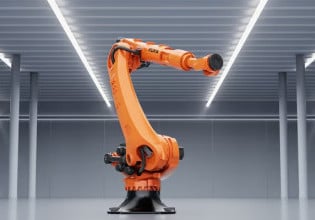Exploring Flexible Automation in Retail and eCommerce
What are the benefits of flexible automation in production, and how are retail and eCommerce businesses implementing this type of automation in their operations?
In this article, we will explore three types of automation: fixed, programmable, and flexible, and take a look at some of the ways flexible automation is being used in retail and eCommerce.

Magazino’s TORU robot. Image used courtesy of Magazino
Types of Automation in Production
Fixed, programmable, and flexible automation are the three main types of production systems designed for certain needs in various industrial sectors. This section defines these automation types in production.
Fixed Automation
Fixed automation uses machinery and equipment that are set up in a specific way to cater to the production of a particular product. Programmed instructions are pre-configured in the physical parts of machinery, such as gears, cams, wiring, and other hardware. The fixed nature of machinery, processing, or assembly operations means it is difficult to switch between making different products. Fixed automation is suitable for large-scale, bulk production of products. This type of automation provides manufacturers with high production rates and incurs a high initial investment.
Programmable Automation
With programmable automation, products are typically produced in batches (between several dozen to a few thousand units at a time). Equipment changeover and reprogramming can lead to unwanted downtime before the production run for a new product batch.
Flexible Automation
Flexible automation is a term used to refer to the use of automated systems that adapt to changing conditions to produce a desired outcome. Operators can reprogram production machinery offline from a central computer terminal to rapidly change over equipment for each new production batch. Flexible automation can reduce costs, increase productivity, and improve product quality by eliminating manual processes.
Flexible Automation for Operation
Implementing flexible automation in eCommerce and warehousing is helping businesses improve productivity and save on labor costs. This technology allows for automated processes to be tailored to specific tasks. This can include anything from robotic arms that pick items off shelves to automated sorting systems that can quickly sort products into various categories. It also better enables companies to manage their inventory levels and order fulfillment times. In addition, this technology can help reduce labor costs while increasing productivity.
Below, we'll look at a couple of examples of flexible automation being used in eCommerce and retail.
Berkshire Grey Partners with Locus Robotics
Recently, a developer of robotic and artificial intelligence solutions, Berkshire Grey, announced its partnership with AMR manufacturer Locus Robotics. The duo teamed up to create a flexible automation solution for tackling eCommerce businesses' ongoing labor shortages.

The Locus Origin AMR. Image used courtesy of Locus Robotics
The solution combines Locus Origin and Locus Vector bots with the Robotic Shuttle Put Wall (BG RSPWi). According to Berkshire Grey, its BG RSPWi increases the throughput of sorting customer orders by 300%. The company also says the bot improves pick rates by 33%. Bots like the BG RSPWi can help retail and eCommerce customers save on labor costs and speed up the order fulfillment process. The BG RSPWi integrates into existing operations and fulfillment processes without disruption.
The Locus Origin AMR is designed to help customers achieve high-volume order fulfillment. The 36 kg payload AMR features an integrated scanner, flexible configuration, a tablet-accessible user interface, a patented tote array, and an accessory port. Through the onboard interface, employees can access multiple languages and carry out tasks with an optional gamification mode.
Locus Origin bots direct employees to choose the appropriate container for picking items. Following this step, the bot travels to the pick location via the most efficient route to meet another employee. The bots work with other bots and human workers to minimize wasted time walking around the warehouse. With omnidirectional mobility, a strong structural framework, and a modest form factor, the Locus Vector AMR is ideally suited to an array of material handling tasks.
Magazino’s TORU Robot
In another recent announcement, eCommerce company Schuurman Schoenen selected Magazino's TORU robot to help implement flexible automation for picking shoeboxes. Magazino develops and manufactures smart mobile robotics solutions for the intralogistics industry.
A demonstration of the capabilities of Magazino’s TORU robot at a warehouse operated by LLOYD Shoes. Video used courtesy of Magazino
Like the Locus bots, TORU uses an intelligent vision system (with 2D and 3D cameras) to pick shelved products and detect the presence of empty shelving. The TORU bot uses a telescoping tower with an above-ground operating range of 8 to 250 cm. It can pick up, lift, and reposition boxes of up to 5.8 kg in weight and uses WiFi to connect to the warehouse management system.
A Focus on Flexibility
Versatility is often essential in the manufacturing process, especially in retail and eCommerce, where a company may need to increase/decrease production at any given time or re-task equipment within a short time. With the use of flexible automation, companies aim for flexible and efficient operation while providing customers with a seamless shopping experience. With flexible automation, companies can focus on efficient operation for faster shipping times, quicker turnarounds, and a seamless shopping experience.






